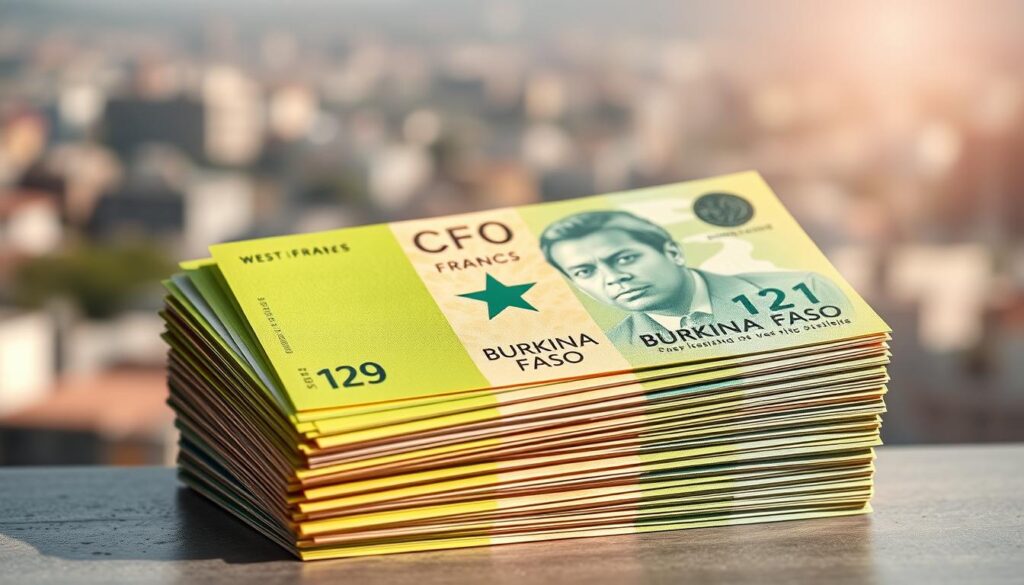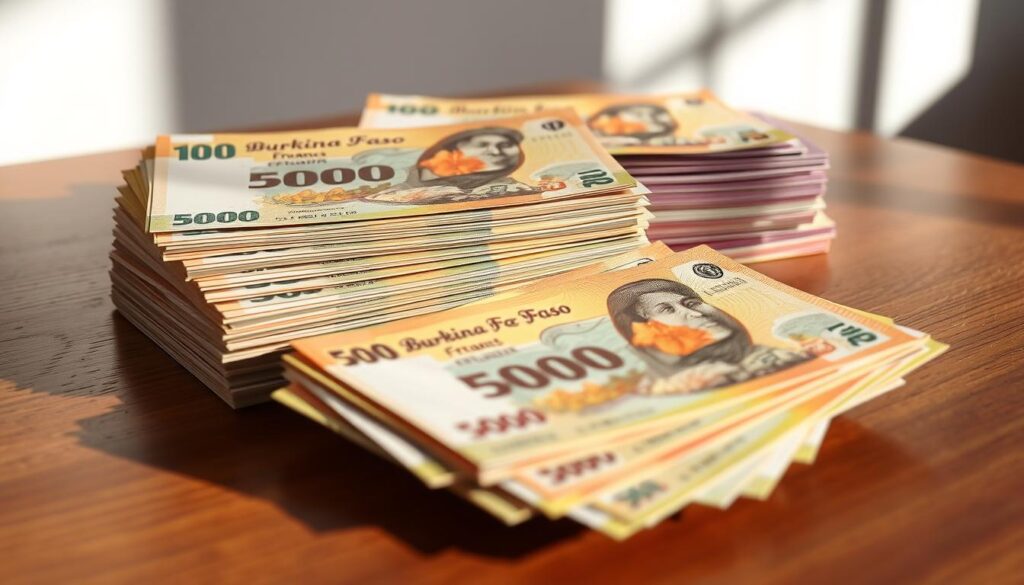
The West African CFA Franc, or XOF, is the official money of eight countries in West Africa. Burkina Faso is one of them. This currency helps these countries work together better in trade and finance.
In Burkina Faso, the XOF is key for all money matters. It’s important for anyone involved in the country’s economy. Using the same money makes it easier to do business and helps countries work together more smoothly.
Key Takeaways
- The West African CFA Franc (XOF) is used by eight West African countries.
- Burkina Faso is a member of the West African Economic and Monetary Union (WAEMU).
- The XOF facilitates economic integration and trade among WAEMU member states.
- Understanding the XOF is essential for trade, investment, and travel in Burkina Faso.
- The shared currency simplifies financial transactions among member countries.
The West African CFA Franc: Burkina Faso’s Official Currency
The West African CFA Franc, or XOF, is the official money in Burkina Faso and other WAEMU countries. It’s not just for buying things; it also shows the unity of these countries economically.
Basic Facts About the West African CFA Franc
The West African CFA Franc is overseen by the Central Bank of West African States (BCEAO) in Dakar, Senegal. The BCEAO keeps the currency stable and makes sure it’s used across the region. Here are some important facts about the West African CFA Franc:
- Eight West African countries use it: Benin, Burkina Faso, Côte d’Ivoire, Guinea-Bissau, Mali, Niger, Senegal, and Togo.
- It’s tied to the Euro, which helps with trade and keeps the value steady.
- It’s broken down into 100 centimes, but you won’t find centime coins anymore.
The CFA Franc Zone and Member Countries
The CFA Franc Zone includes two groups: WAEMU and CEMAC. The West African CFA Franc is for WAEMU countries. This zone is known for:
- A shared currency that helps countries work together economically.
- A fixed rate with the Euro, which keeps money stable.
- Working together on money matters through the BCEAO and BEAC.
Using the West African CFA Franc shows Burkina Faso’s dedication to working with other WAEMU countries for economic stability.
What Currency Does Burkina Faso Use? Understanding the XOF
To understand Burkina Faso’s currency, we look at the West African CFA Franc (XOF). This currency is used in Burkina Faso and other West African countries.
Currency Code and International Designation
The code for the West African CFA Franc is XOF. It’s used worldwide in financial dealings and foreign exchange.
The XOF follows the ISO 4217 standard. This standard lists currency codes for countries globally. It makes international trade and currency exchange easier by using a standard code for the West African CFA Franc.
Burkina Faso Currency Symbol and Visual Appearance
The West African CFA Franc is known as the CFA Franc or just “franc.” It comes in different values, each with its own design and security features to fight counterfeiting.
The currency’s look reflects the area’s culture and history. Banknotes and coins have special designs and security features. For example, banknotes have watermarks and holograms to prove they’re real.
The designs of the currency show the region’s cultural and historical background. Each value is easy to tell apart. This makes buying and selling simple for everyone.
- The currency code XOF is used for financial transactions.
- The symbol CFA Franc or “franc” is used to represent the currency.
- Banknotes and coins are issued in various denominations.
- Distinct designs and security features are incorporated to prevent counterfeiting.
Historical Background of the CFA Franc in Burkina Faso
Burkina Faso’s currency was shaped by its time as a French colony. The CFA Franc was introduced in 1945 for France’s West African colonies, including Burkina Faso. Back then, Burkina Faso was called Upper Volta.
Colonial Origins Under French West Africa
The CFA Franc was part of the French colonial monetary system. It was designed to make trade and financial dealings easier across French West Africa. The currency was tied to the French Franc, which helped keep the economy stable and connected the region.
Key Features of the CFA Franc During Colonial Times:
- Pegged to the French Franc
- Used across French West African colonies
- Facilitated regional trade and economic integration
Post-Independence Monetary Developments
After gaining freedom in 1960, Burkina Faso, then Upper Volta, kept the CFA Franc as its currency. This choice was made for stability and to keep economic ties with France and other West African countries.
| Year | Event | Impact on CFA Franc |
|---|---|---|
| 1945 | Introduction of CFA Franc | Replaced various colonial currencies, unified monetary system |
| 1960 | Burkina Faso gained independence | Continued use of CFA Franc for monetary stability |
The CFA Franc’s continued use after independence shows Burkina Faso’s complex monetary history. It also highlights the country’s ongoing ties with France and the West African economic community.
Denominations and Physical Characteristics
In Burkina Faso, the CFA Franc comes in many banknote and coin types. Each has its own special features.
The West African CFA Franc meets the economy’s needs with different values. It’s available in various denominations.
Banknotes in Circulation
The banknotes range from 500 to 10,000 CFA Francs. They show notable figures and cultural symbols from West Africa.

| Denomination | Features | Security Measures |
|---|---|---|
| 500 CFA Francs | Notable figure from West Africa | Watermark, hologram strip |
| 1000 CFA Francs | Cultural symbol of the region | Security thread, raised printing |
| 2000 CFA Francs | Historical event depiction | Microprinting, UV printing |
| 5000 CFA Francs | Prominent West African leader | Latent image, security thread |
| 10,000 CFA Francs | Significant cultural icon | Hologram patch, raised printing |
Coins and Their Features
The coins range from 1 to 500 CFA Francs. They show the cultural heritage and unity of West Africa.
Coins are made from different materials. They have unique features for easy recognition.
| Denomination | Material | Design |
|---|---|---|
| 1 CFA Franc | Brass | West African map |
| 5 CFA Francs | Stainless Steel | Cultural symbol |
| 10 CFA Francs | Brass | Regional animal |
| 25 CFA Francs | Nickel-plated steel | Historical figure |
| 50 CFA Francs | Bi-metallic | Unity motif |
The Central Bank of West African States (BCEAO)
The Central Bank of West African States (BCEAO) plays a key role in managing the West African CFA Franc. It is the central financial authority for its member countries, including Burkina Faso. The BCEAO oversees the monetary framework of these countries.
Role and Responsibilities in Currency Management
The BCEAO’s main job is to keep the West African CFA Franc stable and trustworthy. It does this by issuing currency, keeping its value, and managing foreign exchange reserves. The bank ensures the currency is backed by enough reserves to maintain confidence.
The BCEAO also regulates and supervises banks and other financial institutions in the WAEMU region. This oversight is vital for keeping the financial system stable and preventing crises.
Monetary Policy in the WAEMU Region
The BCEAO sets policies to promote economic integration and stability in the WAEMU region. It does this by setting interest rates and managing liquidity. These actions support economic growth and keep inflation in check.
The BCEAO’s policies are tailored to the economic needs of its member states, including Burkina Faso. A stable monetary environment helps support trade and investment in the region.
Exchange Rates and Currency Conversion
Knowing the exchange rate between the West African CFA Franc and other currencies is key for anyone visiting or doing business in Burkina Faso. The rate between the XOF and major currencies like the USD changes due to economic factors.

Current Burkina Faso Currency Exchange Rate to USD
The exchange rate between the XOF and USD changes daily. To find the latest rate, check financial news or currency conversion sites. The XOF to USD conversion is affected by the West African Economic and Monetary Union (WAEMU) and global trends.
For example, as of [current date], 1 USD is about [exchange rate] XOF. This rate can change a lot over time because of inflation, trade, and foreign investment.
Historical Exchange Rate Trends
The XOF to USD exchange rate has changed a lot over the years. In the last decade, it has moved with the WAEMU’s and the world’s economic changes.
- The XOF was tied to the French Franc and then the Euro, affecting its stability.
- Economic policies in the WAEMU region have also shaped the exchange rate.
- Global events, like economic crises or changes in commodity prices, have also influenced the XOF to USD rate.
Knowing these trends is vital for businesses and individuals to make smart choices about currency conversion and international deals.
Using Currency in Burkina Faso: Practical Information for Travelers
Cash is often the preferred payment method in Burkina Faso. But, cities are starting to accept card payments and have ATMs. Knowing how to manage your money is key for a smooth trip.
Cash vs. Card Usage in Urban and Rural Areas
In Burkina Faso, cash and cards are used differently in cities and rural areas. Cities like Ouagadougou and Bobo-Dioulasso have better banking and card acceptance. But, in rural areas, cash is the main way to pay.
Urban areas have more places that take cards, like hotels and big stores. But, it’s smart to carry some local money for small buys or at markets.
Rural areas have few places that accept cards. So, it’s important to have enough local money when you go there.
ATMs and Banking Services Availability
ATMs are common in big cities and towns. They let you get the local money, West African CFA Franc (XOF). Banks like BICIAB and Société Générale Burkina Faso have many ATMs.
But, some ATMs might not take foreign cards or work well. Tell your bank you’re traveling to avoid problems.
Banks are open Monday to Friday. Some might be open on Saturdays, but it’s not always the case.
It’s always a good idea to have some local currency with you when traveling, even more so in rural areas where card acceptance is limited.
Being ready and knowing about the local money can make your trip to Burkina Faso better.
Economic Implications of the CFA Franc for Burkina Faso
The CFA Franc has many effects on Burkina Faso’s economy. It brings trade benefits and faces monetary challenges. Being part of the West African Economic and Monetary Union (WAEMU) has big impacts.
Benefits for Trade
The CFA Franc makes trade easier among WAEMU countries. It cuts down on the costs of exchanging money. This boosts economic ties between them.
Trade facilitation is a big plus. It helps goods and services move freely. It also draws in foreign investment, thanks to a stable money system.
Having one currency makes it simpler for businesses to work across borders. This leads to more economic activity and cooperation.
Challenges and Criticisms
But, the CFA Franc system has its downsides. It limits the control of member countries over their money. Being tied to the Euro, managed by France, means Burkina Faso can’t set its own money policies.
Critics say this can hold back the economy. The country’s money decisions are influenced by the European Central Bank.
Another issue is Burkina Faso’s reliance on France. The need to keep some money with the French Treasury is a big worry. It makes the country feel less in control of its finances.
The CFA Franc’s impact on Burkina Faso shows the need for a balanced view. The region must find ways to use the currency union’s benefits while fixing its problems. Looking ahead, it’s key to think about how the money system affects the country’s growth.
The Relationship Between the CFA Franc and the Euro
The West African CFA Franc is tied to the Euro at a fixed rate. This has both supporters and critics. It’s a key part of the monetary policy in the West African Economic and Monetary Union (WAEMU) area.
The Euro Peg Mechanism and Stability
The CFA Franc is pegged to the Euro at a fixed rate of 655.957 CFA Francs per Euro. This fixed rate brings stability and predictability to businesses and investors in Burkina Faso and other WAEMU countries. It’s a big plus, as it lowers the risk of currency changes, making it easier to invest and trade with Eurozone countries.
Benefits of the Euro Peg:
- Reduced transaction costs due to the fixed exchange rate.
- Increased trade with Eurozone countries.
- Monetary stability, attracting foreign investment.
France’s Role in the CFA Monetary System
France has a big role in the CFA Franc, even though the Central Bank of West African States (BCEAO) manages it. The French Treasury backs the CFA Franc’s value against the Euro. In return, the BCEAO must keep some of its foreign exchange reserves with the French Treasury.
| Aspect | Description |
|---|---|
| Exchange Rate | 655.957 CFA Francs per Euro |
| Governance | Central Bank of West African States (BCEAO) with French Treasury oversight |
| Reserve Requirement | Portion of foreign exchange reserves deposited with the French Treasury |
The link between the CFA Franc and the Euro is complex. It offers stability but also limits the WAEMU region’s monetary policy to the Eurozone. France’s influence is significant. This setup affects Burkina Faso’s economy, impacting trade, investment, and stability.
Future of the West African CFA Franc
Plans to replace the CFA Franc with the Eco are moving forward. This could change Burkina Faso’s economy a lot. The Eco is part of a bigger plan to make the West African region more economically connected.
Planned Reforms and the Eco Currency Initiative
The Eco currency is a big step towards uniting West Africa economically. It includes:
- A unified currency system to make trade easier among countries
- More control over money by reducing Euro dependence
- Stable economy through shared money policies
Potential Impact on Burkina Faso’s Economy
The Eco could change Burkina Faso’s economy in many ways. It depends on how the new currency system is set up and the country’s current economic state. Some good things it could bring are:
- More trade and unity in the region
- Stable economy with a shared money policy
- More trust and appeal to foreign investors
But, there are also challenges. Like needing all countries to be economically similar and dealing with short-term economic changes.
Conclusion
The West African CFA Franc is key to Burkina Faso’s economy. It shows the unity of WAEMU member states. The CFA Franc has a long history, starting in the colonial era.
Today, it’s a vital part of the region’s money system. A quick summary shows the CFA Franc is more than just money. It’s a foundation for economic stability in the area.
The currency is tied to the Euro, keeping things stable. It’s used all over, including in Burkina Faso. Now, the region is looking at big changes, like the “Eco” currency.
These changes could greatly affect Burkina Faso’s economy and trade. The future of the CFA Franc is something to watch closely.
To really understand Burkina Faso’s economy, you need to know about the CFA Franc. It’s a symbol of unity and stability. Its future developments are very important.
FAQ
What is the official currency of Burkina Faso?
The official currency of Burkina Faso is the West African CFA Franc (XOF).
What is the West African CFA Franc?
The West African CFA Franc is used by eight countries in West Africa. This includes Burkina Faso. It’s part of the West African Economic and Monetary Union (WAEMU).
Who manages the West African CFA Franc?
The Central Bank of West African States (BCEAO) manages the West African CFA Franc.
What is the currency code for the West African CFA Franc?
The code for the West African CFA Franc is XOF internationally.
What are the denominations of banknotes and coins in circulation in Burkina Faso?
Banknotes in Burkina Faso come in 500, 1000, 2000, 5000, and 10,000 CFA Francs. Coins range from 1 to 500 CFA Francs.
Is the West African CFA Franc pegged to another currency?
Yes, the West African CFA Franc is pegged to the Euro at a fixed rate.
What is the significance of the CFA Franc for trade in the WAEMU region?
The CFA Franc makes trade and investment easier in the WAEMU region. It eliminates the need for currency exchange among member states.
What are the benefits of using the CFA Franc for Burkina Faso’s economy?
The CFA Franc brings stability and predictability to businesses and investors. It also helps with economic integration in the WAEMU region.
What are the criticisms of the CFA Franc monetary system?
Critics say the system limits the monetary sovereignty of member countries. It also depends too much on the French Treasury.
Is there a plan to replace the CFA Franc with a new currency?
Yes, there’s a plan to introduce the “Eco” as a new currency. This is part of efforts to increase monetary sovereignty and deepen economic integration in West Africa.
How does the CFA Franc affect travelers to Burkina Faso?
Travelers to Burkina Faso should know that cash is key in many places. But, cities like Ouagadougou have more developed banking, with ATMs and card acceptance becoming common.
Can I use credit or debit cards in Burkina Faso?
Card acceptance is growing in cities, but cash is preferred in many areas.
How can I exchange my currency for CFA Francs in Burkina Faso?
You can exchange your money for CFA Francs at banks, currency exchange offices, or use ATMs to withdraw cash.

Adam G
This post was created by Adam G, a seasoned financial writer with a passion for explaining currency exchange and market movements
